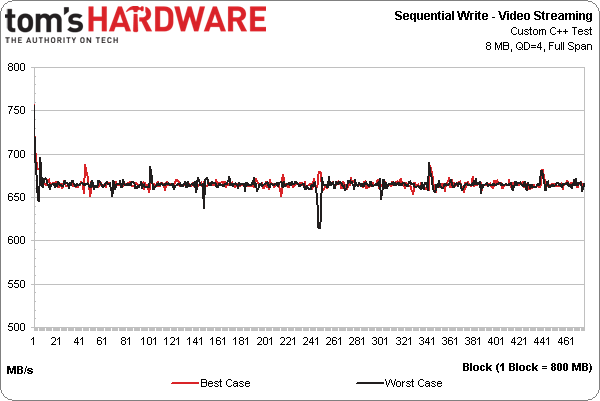LSI SAS 9300-8e & HGST Ultrastar SSD800MM: 12 Gb/s SAS, Tested
With the announcement of LSI's SAS 9300-8e and HGST's Ultrastar SSD800MM earlier this year, the world was officially introduced to 12 Gb/s SAS. Today we get our first look at how two times the interface bandwidth translates to real-world performance.
Results: Enterprise Video Streaming Performance
Video streaming is a demanding workload within the enterprise space. Companies want more HD streams with higher bit-rates and no stuttering. A storage solution well-suited for enterprise-class video delivery has completely different capabilities than something designed for databases. At the end of the day, you're basically looking for exceptional large-block sequential write performance. You also need a high level of consistency that traditionally isn't seen from consumer SSDs. For a more in-depth analysis, take a look at page 10 of Intel SSD 910 Review: PCI Express-Based Enterprise Storage.
Once the drive is in a steady state, we write its entire capacity 100 times. We use 8 MB transfer sizes and a queue depth of four, recording timestamps for each individual write. The graph below reflects 100-point averaging, so that you can better visualize the results.
Performance is fairly consistent across the entire span of the drive. We weren't able to hit the 700 MB/s mark seen in the shorter tests, but we still sustained a healthy 660 MB/s. There were a few dips during our runs. None of them were major, though. With all of that said, it was a little surprising that the SSD800MM wasn't more consistent, especially considering its excellent random write consistency.
| Threshold | Best-Case Buffer Size | Worst-Case Buffer Size |
|---|---|---|
| 620 MB/s | 19 MB | 30 MB |
| 630 MB/s | 20 MB | 83 MB |
| 640 MB/s | 20 MB | 137 MB |
| 650 MB/s | 21 MB | 191 MB |
| 660 MB/s | 22 MB | 246 MB |
| 670 MB/s | 2239 MB | 2550 MB |
Even looking at a worst-case scenario, you only need a minimal amount of buffering to maintain 660 MB/s. It might be smart to back off of that number a bit though, since going over will cause your buffering needs to soar.
Get Tom's Hardware's best news and in-depth reviews, straight to your inbox.
Current page: Results: Enterprise Video Streaming Performance
Prev Page Results: Sequential Performance Next Page 12 Gb/s SAS: An Impressive Demonstration Of Speed-
major-error The performance and relative maturity of this prototype drive certainly is impressive, but this is what the enterprise space demands.Reply
At the consumer level though, the article takes on a completely different tone--I would be very surprised if we don't start seeing mention of PCIe4 at/before the top of the next CPU cycle (so, in 24-36 months at most.) -
raidtarded Actually, Adaptec already saturated PCIe 3.0 with 6GB/s. The chart is incorrect, it doesn't take 12Gb/s to saturate the PCIe bus. Well, not for Adaptec.Reply -
falcompsx Remember when mechanical hard drives struggled to saturate their interfaces? Times sure have changed with SSD tech.Reply -
CaedenV Reply11006286 said:The performance and relative maturity of this prototype drive certainly is impressive, but this is what the enterprise space demands.
At the consumer level though, the article takes on a completely different tone--I would be very surprised if we don't start seeing mention of PCIe4 at/before the top of the next CPU cycle (so, in 24-36 months at most.)
Ya, my bet is that we will not start to see SATA4 or PCIe4 until Skymont at the earliest. Considering it is looking like Broadwell may be pushed back due to 14nm die shrink issues I would bet that Skymont will have similar issues when moving to 10nm. But at least for home users you can cram 2 SSDs in RAID0 with a proper RAID card and get a little performance boost until then. I guess the only problem is that most people are going to use the onboard Intel RAID for RAID0, which will get you a killer synthetic benchmark, but in practical reality it is really just expanding your volume with very little speed benefit. -
bit_user * wipes drool off floor *Reply
That's a quality review of some quality products. I like the insights shared, throughout. I especially appreciated the link to the SATA-Express paper. Thanks!
MORE REVIEWS LIKE THIS!!
:) -
bit_user Reply
How many ports and how many lanes, though? If it's just a 8-port card, the math doesn't support that, as 6x8 = 48 Gbps, which is less than the 8 x 8 = 64 Gbps that a x8 PCIe 3.0 slot should carry.11006482 said:Actually, Adaptec already saturated PCIe 3.0 with 6GB/s. The chart is incorrect, it doesn't take 12Gb/s to saturate the PCIe bus. Well, not for Adaptec.
-
raidtarded It is the equivalent of a nuke bomb compared to the LSI products. It has 24 Native ports.Reply11011736 said:
How many ports and how many lanes, though? If it's just a 8-port card, the math doesn't support that, as 6x8 = 48 Gbps, which is less than the 8 x 8 = 64 Gbps that a x8 PCIe 3.0 slot should carry.11006482 said:Actually, Adaptec already saturated PCIe 3.0 with 6GB/s. The chart is incorrect, it doesn't take 12Gb/s to saturate the PCIe bus. Well, not for Adaptec.
